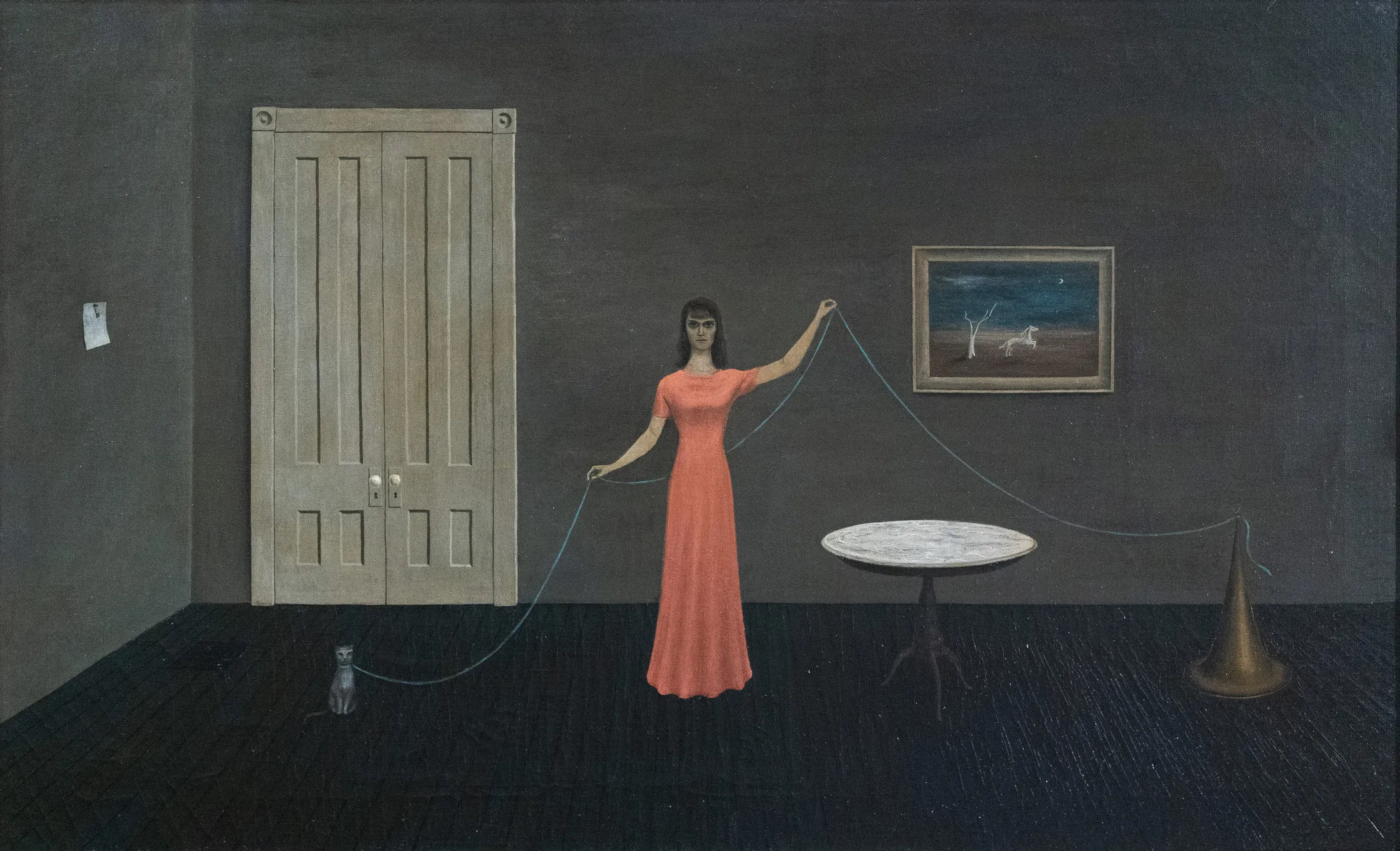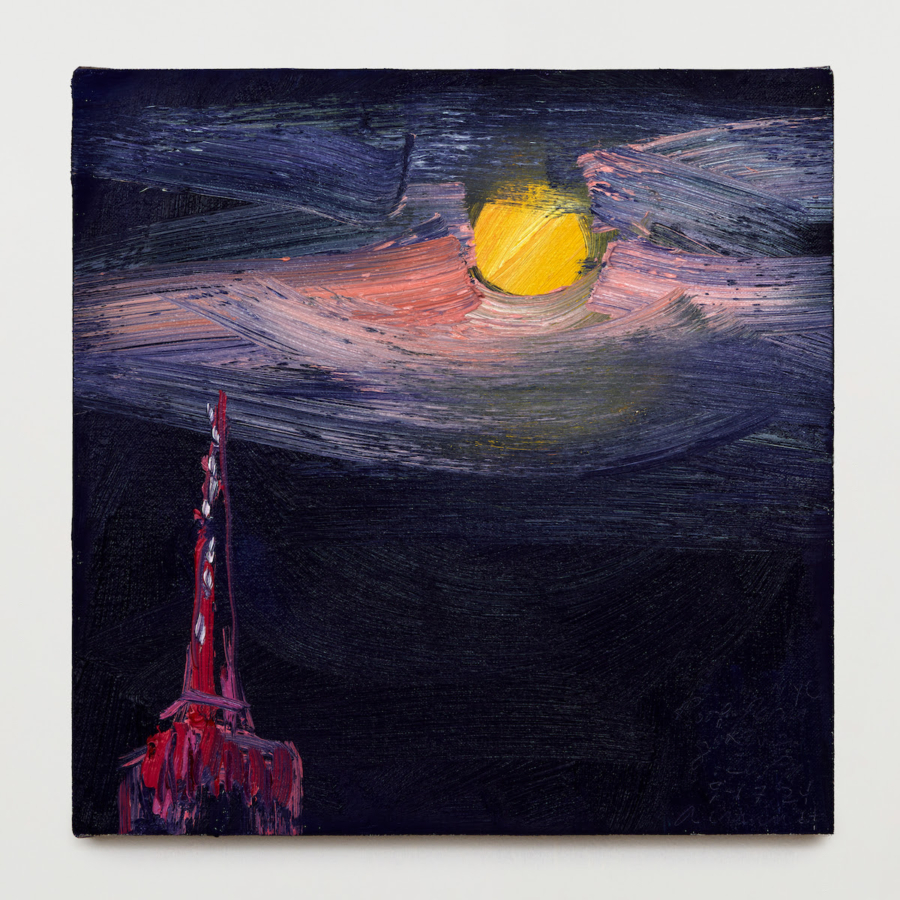
March 10, 2025
“Simple things that are a little strange” is how Chicago painter Gertrude Abercrombie described her enigmatic works that locate the peculiar in everyday life.
Nearly 50 years after her death, this under-considered fixture of American Surrealism has recently seen a surge of interest following an acclaimed 2018 show at New York’s Karma gallery. Now a new touring exhibition invites viewers to meet the artist fully for the first time.
“Gertrude Abercrombie: The Whole World Is a Mystery,” on view through June 1 at Pittsburgh’s Carnegie Museum of Art, is the most comprehensive museum presentation of the artist’s work to date, with some 80 paintings from the late 1930s until her death in 1977 at age 68.
Abercrombie deployed a concise visual lexicon of personal symbols and a restrained sober palette across her paintings of interiors, landscapes, and still lifes, which were strewn with everyday objects and scenes—seashells, eggs, black cats, owls, snails, doors, bowls of fruit, Victorian furniture, bare trees, and moonlit landscapes among them. Although mined from her dreams with the aid of psychoanalysis, her works are grounded in the reality of her life experiences and emotional states (not to mention the flat Midwest landscape). “I try to make it real,” she said of her work. “I often find my paintings more real than the world around me.”
Abercombie often inserted herself into that world, by turns tense, lonely, and punctuated with humor—as a cat, a figure in a witch hat (which she often wore around her neighborhood), even a crescent moon. Each painting is a self-portrait of some kind, points out curator Eric Crosby, and deeply personal, whether drawn from internal or external reality. “Her dreams were very real for her,” Crosby emphasizes, “and her attempts to paint them directly were the project of her work.”
She also found the fantastic in the real. Her Demolition Doors series, for instance, draws its peculiarity from the actual salvaged wooden doors that fenced off construction sites as Chicago’s predominantly Black Hyde Park neighborhood underwent urban renewal in the late ’50s; they can be read, the show suggests, as exhortations against racist policies that were transforming her community.
And though suffused with stillness, her psychologically charged spaces suggest a tempestuous interior life, perhaps the result of a difficult relationship with her mother, a lack of confidence in her appearance, tumultuous marriages, and alcoholism. “Each is a kind of tone poem expressing a different emotion,” Crosby notes.
But what he finds particularly fascinating is beyond the frame of her paintings. A largely self-taught white woman artist, Abercrombie married and divorced twice, had many lovers, and showed little interest in motherhood. Instead, she surrounded herself with queer artists and poets and Black luminaries of the Chicago jazz scene in her decades holding court in a grand, dusty Victorian in bohemian Hyde Park. Trumpeter Dizzy Gillespie, a close friend, anointed her “the bop artist” due to the repetition of objects in her visual lexicon, similar to how jazz musicians created bebop by improvising on fixed chord patterns. “She has taken the essence of our music and transported it into another form of art,” Gillespie once said.
“Gertrude was always so open and embracing, and she swam in this ocean of artists from so many different backgrounds and disciplines, figures who didn’t feel like they had a place in the dominant culture,” Crosby says. The exhibition title evokes “the spirit of wonder and openness she brought to the world around her,” he adds. “You get a sense from her work and life that she is in it for the fullness. I’m very inspired by her life just as much as her paintings.”
Indeed, the renewed appreciation for Abercrombie at this moment may be due to what Crosby calls “the many different Gertrudes implied by her work,” as she sought to identify the various aspects of her lived experience and incorporate them into her paintings. “That’s a very contemporary perspective, to try to understand the many different facets of oneself and how they can show up in creative practice,” he observes. “There’s a queerness in that, an inclusivity, and potential for anybody to find a way into the work.”
Crosby hopes the show, which will travel to Colby College in Maine (which coorganized and cocurated the presentation) and the Milwaukee Art Museum, prompts a reconsideration not only of Abercrombie but of American modern art narratives broadly. “We should be asking not just who we can add to the canon but why the canon has been so limited,” he says. “There are so many other artists whose stories have yet to be told who were really quite defining in what we understand to be American art today.”
Abercrombie latterly admitted to being influenced by René Magritte, cheekily calling him her “spiritual daddy.” But her work doesn’t fit squarely under Western European Surrealism, explains Crosby (who prefers to call it magical realism); while American artists may have come across Surrealist works in reproduction or exhibitions, they weren’t immersed in its cultural context. Instead, he observes, Abercrombie’s work is “grounded in a uniquely American experience, one that was deeply inclusive and steeped in jazz and poetry and life in Chicago.” After all, as Abercrombie herself put it, “There is magic everywhere if you stop and look and listen.”


